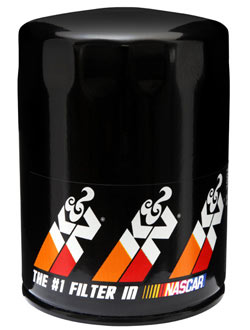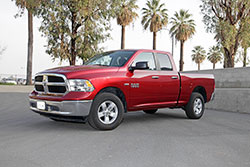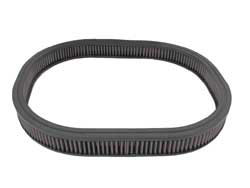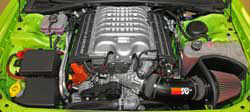|
One of the most popular engines among rodders and racers is the Hemi V8. But there are actually three generations of the legendary engine. Generation I, of which there were different versions and displacements for Chrysler, DeSoto, and Dodge cars throughout the 1950s. The reemergence of the Hemi as the Generation II “Elephant” motor, used in both racing and to power some of the fastest and most desirable street cars of the day, and then the modern Generation III Hemis, used in Ram trucks and Dodge and Chrysler performance cars.

High Performance, Pro Series, or Billet, K&N builds three versions of the 3001 filter that fits many Gen II Hemi engines |
How well do you know your Hemi history? Below are some questions and fun facts about the Hemi. It’s not intended to be a test of your memorization of bore:stroke ratios, but rather to arm you with some trivia for the next time the conversation turns to Hemi engines.
In what year did Chrysler introduce its first Hemi engine?
Called the FirePower, it was used in Chrysler passenger cars from 1951 to 1955. Most were equipped with a two-barrel carburetor and produced 180 horsepower until the 1955 model year.
Did you know the Hemi was actually outlawed from racing in the Indy 500?
In late 1952, a specially-prepared 331 CID fuel-injected Chrysler Hemi engine, producing 410 horsepower, was fitted to a Kurtis Kraft 500A roadster (a state-of-the-art Indy car of the time) and tested at the Indianapolis Motor Speedway. It ran a simulated 500 mile race which it completed four mph faster than the race record. Alarmed, officials lowered the maximum displacement for stock block engines from 340 CID to 270 CID. Chrysler chose to withdraw.

Add an estimated 15.66 rear-wheel horsepower to your 2013 RAM 1500 with the 50-State legal K&N intake system |
Was Hemi the first US production engine to produce one horsepower per cubic inch
The 354 CID engine was released for the 1956 model year. The 354 was installed in the Chrysler 300B and available with an optional 355 horsepower version, making it the first American passenger car engine to be rated at one horsepower per cubic inch.
Was the original 426 Hemi intended to be a race-only engine?
The Generation II Hemi engine displaced 426 CID, with dimensions so large it was nicknamed the “Elephant” by Chrysler engineers. Intended only as a race engine, Richard Petty debuted the Generation II Hemi at Daytona, where he laps the entire field on his way to winning the Daytona 500. It’s was a clean 1-2-3 sweep for the 426 Hemi at the 1964 Daytona 500. Chrysler was instructed to offer the Hemi to the public before the engine could return to NASCAR.
Which driver was the first to use a Hemi to crack 200 mph on the strip?
Don Garlits shattered the 200-mph quarter-mile barrier in a 426 Hemi-powered Top Fuel dragster in August at Island Dragway with an ET of 7.78 seconds and trap speed of 201.34 mph. If you’re into nostalgia drags, K&N manufacturers the PS-3001 oil filter that’s a perfect match to the needs of an “Elephant” motor running the strip.

Should you own one of the 11 Hemi-powered 1971 ‘Cuda convertibles, rest assured that K&N makes a drop-in replacement air filter worthy of your multi-million-dollar car |
When was the 426 Hemi first available to retail customers?
Chrysler began to offer a slightly detuned version of the Generation II 426 Hemi in production cars for the 1966 model year. NASCAR approved the 426 Hemi for competition. Richard Petty again won the Daytona 500 in his Hemi-powered Plymouth Belvedere. K&N offers both an air filter and a high-flow fuel filter for Hemi-powered 1966 Plymouth Belvederes, part numbers E-1540 and PF-1300, respectively.
In what year did Chrysler bring back the “Elephant” 426 Generation II Hemi as a crate motor?
The year was 1992 - a year when rodders and restorers were extremely happy.
What’s the highest price ever paid for a Hemi-engined car?
In 2014, a numbers-matching Hemi-powered 1971 Plymouth ‘Cuda four-speed convertible sold at auction for $3.5 million. It was just one of 11 Hemi ‘Cuda convertibles manufactured in 1971, and experts believe it may be the only matching-numbers ’71 Hemi ‘Cuda convertible left. If you should find yourself the owner of any 1971 Hemi-powered ‘Cuda, rest assured that the K&N produces an air filter for your car, part number E-1980.

The K&N Typhoon air intake adds an estimated 38.95 rear-wheel horsepower to an otherwise stock Dodge Charger Hellcat 6.2-liter Hemi V8 |
When did the Generation III Hemi make its appearance?
The Hemi returned in 2003 as an all-new 5.7-liter V8 for the Ram 1500 pickup truck. The Generation III Hemi developed up to 345 horsepower. By 2011, with better engine management computers, the 5.7 L Hemi was producing 395 horsepower in the Ram 1500. In fact, you can raise the output an estimated 15.66 horsepower on a 2013 1500 with the 50-State legal K&N intake system, part number 57-1561.
Which major landmark Hemi event occurred in 2015?
In 2015 Chrysler released the Hellcat version of the Hemi, a 6.2 L V8 with an integrated supercharged and intercooler, which raised power output to 707 horsepower. The Hellcat-equipped Challenger and Charger became the most powerful muscle cars built by Chrysler, in either the current or classic eras. But K&N allows you to take it even further. The K&N cold air intake, part number 69-2550TTK, when installed on an otherwise stock Dodge Charger Hellcat 6.2-liter and dyno tested, the results showed an estimated increase of 38.95 horsepower and 21.01 lb-ft of torque at the rear wheels.
Hellcat or RAM, 1971 Hemi Cuda or Nostalgia Top Fuel dragster, K&N makes products for your vehicles. In fact, if it has wheels and an engine, whether it’s a diesel truck or a motor scooter, K&N most likely has filters that fit your application. Use the K&N vehicle search tool to find the right part for your vehicle.
Some intake systems are not legal for sale or use on any pollution controlled motor vehicle in California or states adopting California emission procedures. See knfilters.com for CARB status on each part for a specific vehicle.
|













